Heredity And Evolution Class 10 Notes
Class 10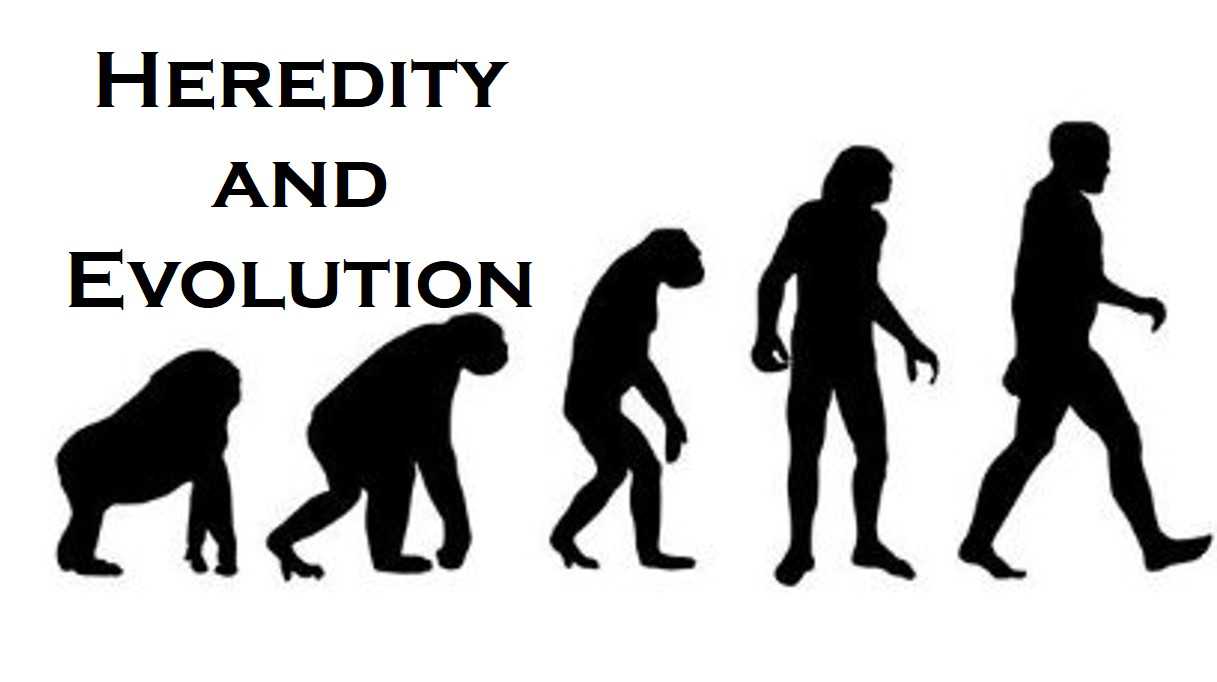
Welcome to the world of Heredity and Evolution Class 10 Notes, students are introduced to the fascinating concepts of genetics and evolution that shape life as we know it. Heredity refers to the passing of traits from parents to offspring, while evolution describes the changes in species over time through the process of natural selection. These topics are essential to understand the diversity of life and the complex mechanisms that drive it. Through these "Heredity and Evolution Class 10 Notes," students will explore the basic principles of genetics, including Mendelian laws, inheritance patterns, and DNA replication. Additionally, they will delve into the theory of evolution, its evidence, and its role in shaping the biological world. These notes aim to provide students with a comprehensive understanding of these fascinating topics, enabling them to appreciate the intricacies of life and develop a deeper understanding of their place in the world. So, let's begin our journey into the fascinating world of Heredity and Evolution!
Heredity and Inherited Traits Mendel conducted an experiment on heredity and inherited traits, including sex determination. Inherited traits are genetically determined features that distinguish individuals from one another, such as attached or free earlobes in humans. Heredity involves the transmission of these characters from parents to offspring.
Rules for the inheritance of traits
Gregor Johann Mendel, known as the "Father of Genetics," discovered the rules for the inheritance of traits in human beings, which are based on the equal contribution of genetic material or DNA from both parents to their offspring. Mendel worked out the rules for the inheritance of these traits by conducting experiments with garden peas (Pisum sativum) in the garden behind his monastery. He observed a number of contrasting characters in garden peas and how they were inherited. As a result of his work, it became clear that an offspring receives two versions of a trait from their parents.
Some important terms
-
Chromosomes, which contain hereditary information in the form of genes, are long thread-like structures present in the nucleus of a cell.
-
DNA, a chemical present in chromosomes, carries traits in a coded form.
-
A gene, which controls a specific biological function, is a part of a chromosome.
-
Contrasting characters are pairs of visible characteristics, such as tall and dwarf, white and violet flowers, round and wrinkled seeds, and green and yellow seeds.
-
The dominant trait is the character that expresses itself in the first generation (F1). For example, tallness is a dominant character in pea plants.
-
The recessive trait is the character that does not express itself but is present in a generation. For example, dwarfism is a recessive trait in pea plants.
-
Homozygous refers to a condition in which both genes of the same type are present. For example, an organism with both genes for tallness is expressed as TT, and genes for dwarfness are written as tt.
-
Heterozygous refers to a condition in which both genes are of different types. For example, an organism with genes Tt has a gene for tallness and the other for dwarfness, but only the tall character is expressed.
-
Genotype refers to the genetic makeup of an individual. For example, a pure tall plant is expressed as TT and a hybrid tall plant as Tt.
-
Phenotype refers to the external appearance of the organism. For example, a plant with Tt composition will appear tall, although it has the gene for dwarfness.
-
Homologous pairs of characters are pairs in which one member is contributed by the father and the other by the mother. Both members have genes for the same character at the same position.
Mendel’s Experiment: Mendel started his experiment on the pea plants. He conducted first monohybrid and then dihybrid crosses.
Monohybrid Cross
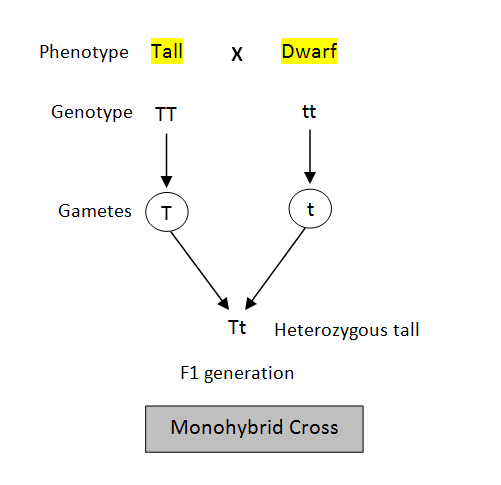
The cross in which Mendel showed inheritance of dominant and recessive characters is monohybrid cross. To observe inheritance of single pair of contrasting characters
he took pure tall (genotype TT) and pure dwarf (genotype tt) pea plants and cross pollinated them to obtain first generation or first filial generation. In this figuration (F1 generation) he obtained only tall plants. This meant that only one of the parental traits was seen, not the mixture of the two. The plants of F generation or progeny are then self pollinated to obtain F2 generation or progeny. Now all plants were not tall. He obtained 75% tall plants and 25% dwarf plants i.e. the phenotypic ratio was 3:1. This indicates that in the F, generation both tall and dwarf traits were inherited but tallness expressed it self. Tallness is a dominant trait and dwarfness is a recessive trait. F2 generation has a genotypic ratio of 1 : 2 : 1 of three types of plants represented by TT, Tt and tt as shown in the cross
Conclusion: Phenotypic ratio—Tall : Dwarf 3 : 1
Genotype ratio—Pure Tall : Hybrid Tall : Pure Dwarf 1 : 2 : 1
Law of Dominance: When parents having pure contrasting characters are crossed then only one character expresses itself in the Ft generation. This character is the dominant character and the character/factor which cannot express itself is called the recessive character.
Dihybrid Cross - Heredity And Evolution Class 10 Notes
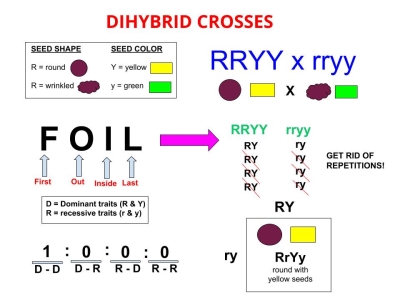
Mendel conducted experiments to observe the inheritance of two pairs of contrasting characters, which is referred to as a dihybrid cross. He performed a cross between pea plants bearing round green seeds and plants bearing wrinkled and yellow seeds. In the F1 generation, he obtained all round and yellow seeds, indicating that the round and yellow traits of seeds are dominant features, while wrinkled and green are recessive. He self-pollinated the plants of the F1 generation to obtain the F2 generation, where he observed four different types of seeds: round yellow, round green, wrinkled yellow, and wrinkled green in the ratio of 9:3:3:1. He concluded that traits are independently inherited.
Conclusion
- Round and yellow seeds-9.
- Round and green seeds-3.
- Wrinkled and yellow seeds-3.
- Wrinkled and green seeds-1.
How do traits get expressed? -Heredity And Evolution Class 10 Notes
The information for making proteins in a cell is derived from cellular DNA. A gene is a part of the DNA that provides information for a specific protein. For instance, the height of a plant depends on the growth hormone which is regulated by a gene. If the gene is effective and releases more growth hormone, the plant will grow tall. Conversely, if the gene for that particular protein is altered and releases less growth hormone, the plant will remain short. During sexual reproduction, both parents contribute equally to the DNA of the next generation. They provide a copy of the same gene. For example, when a tall plant is crossed with a short plant, the gametes will have a single gene for either tallness or shortness. The F1 generation will have one gene for tallness and one for shortness.
Cells that give rise to sperm and eggs, called germ cells or gametes, receive one set of genes from each parent. This is because each gene set is present as separate pieces called chromosomes. Each cell gets two copies of each chromosome, one from each parent, but during the formation of gametes, there is a reductional division which results in each gamete receiving only one copy of each chromosome. When the sperm fertilizes the egg, the normal number of chromosomes is restored in the offspring, ensuring the stability of the species' DNA.
The determination of the sex of a newborn individual is a process that involves the inheritance of sex chromosomes from the parents. In humans, females have two X chromosomes, while males have one X and one Y chromosome. The sex of the offspring is determined by whether the sperm carrying an X or a Y chromosome fertilizes the egg. If an X-bearing sperm fertilizes the egg, the offspring will be female, while if a Y-bearing sperm fertilizes the egg, the offspring will be male.
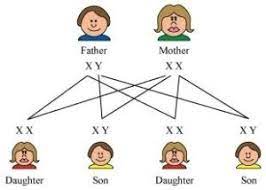
Autosomes: Those chromosomes which do not play any role in sex determination
Sex chromosomes - Heredity And Evolution Class 10 Notes
The chromosomes that determine the sex of a newborn are involved in the process. If a sperm carrying an X chromosome fertilizes an ovum with an X chromosome, the resulting baby will have XX chromosomes and be female. If a sperm carrying a Y chromosome fertilizes an ovum with an X chromosome, the resulting baby will have XY chromosomes and be male.
Evolution -Heredity And Evolution Class 10 Notes
It is the sequence, of gradual, irreversible changes which took place in the primitive organisms over millions of years to form new present-day species. Variations that resulted in formation of new species occurred basically due to errors in DNA copying as well as due to sexual reproduction.
An Illustration to show variations in a population: A group of twelve red beetles live in green bushes and reproduce sexually so are likely to develop variations. There are the following possibilities.
First situation
Crows eat these beetles as they can easily pick up red ones in the green bushes There is a colour variation during sexual reproduction and green beetles appears, it reproduces and its population increases. Crows are not able to see green beetles so their population continues to increase but that of red beetles decreases. This type of variation gives a survival advantage.
Second situation
Due to a colour variation few blue beetle appear forming blue population. Crows can see both red and blue and eat them. Initially there are more of red beetles and less of blue. There is sudden calamity, an elephant kills red beetles by stamping on bush, blue beetles survive reproduce and increase in number. In this case there is no survival advantage but provides diversity without any adaptation.
Third situation
As the population of beetles increases, the bushes suffer from a disease and the availability of food for beetles decreases. The size of beetles decrease but after a few years as the plant disease is eliminated and enough food is available for the beetles they come back to their normal size. This type of change is not inherited.
Acquired Traits: Acquired traits are those which are not inherited over generations as they are caused due to change in the non-reproductive tissue and are not passed on the DNA of the germ cells for example; the size of the beetles in the population decreased due to scarcity of food.
Inherited Trait: Inherited traits are caused due to changes in the DNA of germ cells which are inherited from generation to generation, for example; formation of green beetles in the population of red beetles.
Acquired Traits and Inherited Traits -Heredity And Evolution Class 10 Notes
| Criteria | Acquired Traits | Inherited Traits |
|---|---|---|
| Definition | Characteristics that an individual acquires during lifetime | Characteristics that an individual inherits from its ancestors |
| Source | Environment, lifestyle, behavior | Genes and DNA |
| Time of occurrence | After birth or during lifetime | At the time of conception or birth |
| Passed to offspring? | No | Yes, can be passed to offspring through DNA |
| Examples | Calluses on hands, tanned skin, knowledge of a foreign language | Eye color, hair type, height, susceptibility to certain diseases |
Charles Darwin’s Idea of Evolution: His concept of evolution was based on the idea that new species were formed due to variations that occurred in the organisms Nature played an important role in selecting the organisms having suitable variations.
Speciation: It means the development of one or more species from an existing species The factors that could lead to rise of a new species are :
Gene flow: It means the exchange of genetic material by interbreeding between populations of the same species or between individuals within a population. It increases the variation in the genetic composition of a population.
Genetic drift: It is random change in the frequency of alleles in a populate over successive generation due to errors in the gametes. The process is rapid in smaller population. Genetic drift can lead to accumulation of changes in the generations.
Natural selection: According to Darwin, natural selection also plays an important role in bringing about evolution of new species of plants and animals. According to him variations existed between the individuals of a population and some natural phenomena eliminated those individuals which were less adapted. The surviving population would pass the hereditary advantageous features to their offsprings. With time this process would give rise to organisms different from the original population and new species are formed.
Isolation: When a population of a species splits into two, it cannot reproduce with each other and forms a new species, for example; when a population of beetles feed on bushes on a mountain range, some may start feeding on nearby bushes finding entry into a new subpopulation. They reproduce with them so genes enter in a new population. Ultimately the two groups will be incapable of reproducing with each other and new species will be formed.
Evolution and Classification: The organisms show certain features, like appearance and behaviour which are called characteristics for example; Plants can perform photosynthesis. The basic characteristics are shared by a large number of organisms. More characteristics which two species have in common more closely are related, if they are more closely related then they have common ancestors (explain the example of brother sister and cousins). Evolutionary relationships can be traced with the help of the following :
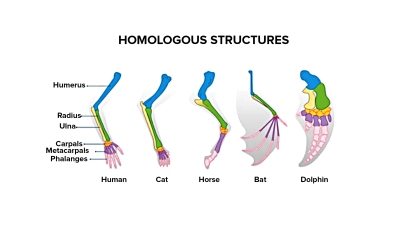
Homologous organs: Those organs which have the same basic structural design and developmental origin but perform different functions and appearance, for example; Forelimbs of frog, lizard, bird, bat and human beings. They have same design of bones but they perform different functions.
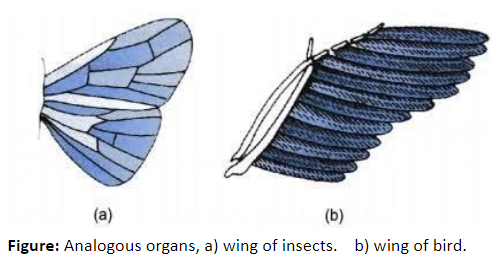
Analogous organs: Those organs which have different basic design and developmental origin but have similar appearance and perform a similar function, for example; wings of bat and bird. Wings of bat are folds of skin attached between fingers. But wing of birds are modified forelimbs.
Study of Fossils
Fossils, which are preserved remains of living organisms that lived in the past, are created when the bodies of organisms do not decompose due to the environment in which they are found. For instance, if a dead insect is caught in hot mud, the mud will harden and retain impressions of the body parts of the insect, which are also known as fossils. There are two methods used to estimate the age of a fossil:
-
The first method is based on the depth at which the fossil is found. Fossils closer to the earth's surface are more recent than those found in deeper layers.
-
The second method is called isotope dating. This method involves detecting the ratio of different isotopes of the same element in the fossil material.
Evolution by stages
Evolution occurs as a gradual and continuous process, where complex organs are not formed by a single DNA change, but rather through gradual changes over many generations. For instance, complex organs like eyes evolved gradually, with rudimentary eyes in some insects providing a fitness advantage in the meantime. The structure of the eye in all organisms is different, indicating evolutionary origins. Additionally, some organs may have initially developed for one function but later became useful for another, such as feathers that evolved for warmth but later aided in flight.
Feathers have been discovered on some dinosaurs that could not fly, indicating that birds are closely related to reptiles as dinosaurs were reptiles. Structures that may appear dissimilar can also have evolved from a common ancestor. One example of this is the wild cabbage plant, which has been artificially selected to generate various vegetables, rather than evolving through natural selection.
- Selection of short distance between the leaves has led to formation of cabbage that, we eat.
- Selection for arrested flower development had led to broccoli,
- Selection for sterile flowers had made cauliflower,
- Selection for swollen-stem had formed kohlrabi.
- Selection for large leaves had formed leafy vegetable kale,
- Selection for colored leaves formed red cabbage.
Evolution versus Progress: Evolution can not be called progress from lower forms to higher forms. It is basically forming more complex designs while the simpler once also keep growing. Evolution is generation of diversity with the help of environmental selection. Bacteria which were formed first have the capacity to live in diverse conditions and are still flourishing; on the other hand human beings which are highly evolved species can not be called the pinnacle of evolution but yet another species in the evolving life forms.
Human Evolution: Human evolution has been studied with the help of excavation; time dating and fossil study All human beings belong to single species i.e. Homo sapiens. Human species have come from Africa. Some of our ancestors left Africa while others stayed on. These migrants slowly spread across the planet i.e. West Asia, Central Asia, Eurasia, South Asia and East Asia They traveled to Indonesia, the Philippines, Australia and America They traveled forward and backward sometimes separating and sometimes coming back to mix with each other. They had come into being as an accident of evolution.
Although there is a great diversity of human forms all over the world get all humans are single species.
- They didn’t go in a single line.
- They went forward and backward.
- Moved in and out of Africa.
- Sometimes come back to mix with each other.
Download the eSaral App for complete Class 10 Video lectures, Study material, revision and much more.
Heredity And Evolution Class 10 Notes
